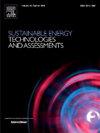Advancing just transition: The role of biomass co-firing in emission reductions and employment for coal regions
IF 7.1
2区 工程技术
Q1 ENERGY & FUELS
Sustainable Energy Technologies and Assessments
Pub Date : 2025-03-01
DOI:10.1016/j.seta.2025.104246
引用次数: 0
Abstract
As efforts to mitigate carbon emissions intensify, the issue of justice in the transition process has gained significant attention. The environmental impacts of low-carbon technologies, such as renewable energy, have been widely evaluated. This study develops an integrated model to quantify the employment effects of biomass co-firing retrofitting for coal plants and to explore its optimal ratio. We also modified a plant-level carbon emission calculation method to analyze the trade-off between carbon emissions and social benefits. Our results indicate that when the blend rate of coal and biomass exceeds 90%, there are noticeable changes in job creation. However, the maximum job creation value is negative, suggesting that biomass co-firing technology is not an effective choice for achieving a just transition during the large-scale coal phase-out process, and it is less competitive compared to renewable energy. Additionally, we find that generation efficiency is linearly negatively correlated with the blend rate. Moreover, carbon emission intensity and job intensity are positively correlated linearly, while there is a nonlinear negative correlation between job intensity and the blend ratio. Overall, biomass co-firing appears insufficient for a just transition in coal phase-out, indicating a need for regionally adaptive blend ratios for optimal operation.
推进公正转型:生物质共烧在煤炭地区减排和就业中的作用
随着减少碳排放的努力的加强,过渡过程中的正义问题得到了极大的关注。可再生能源等低碳技术对环境的影响已得到广泛评估。本研究建立了一个综合模型来量化燃煤电厂生物质共烧改造的就业效应,并探索其最佳比例。我们还修改了植物层面的碳排放计算方法,以分析碳排放与社会效益之间的权衡。我们的研究结果表明,当煤炭和生物质的混合率超过90%时,创造的就业机会发生了明显的变化。然而,最大就业创造价值是负的,这表明生物质共烧技术不是在大规模煤炭淘汰过程中实现公正过渡的有效选择,与可再生能源相比,它的竞争力较弱。此外,我们发现发电效率与混合率呈线性负相关。碳排放强度与工作强度呈线性正相关,而工作强度与混合比呈非线性负相关。总的来说,生物质共烧似乎不足以实现煤炭逐步淘汰的公正过渡,这表明需要区域适应性混合比例以实现最佳操作。
本文章由计算机程序翻译,如有差异,请以英文原文为准。
求助全文
约1分钟内获得全文
求助全文
来源期刊

Sustainable Energy Technologies and Assessments
Energy-Renewable Energy, Sustainability and the Environment
CiteScore
12.70
自引率
12.50%
发文量
1091
期刊介绍:
Encouraging a transition to a sustainable energy future is imperative for our world. Technologies that enable this shift in various sectors like transportation, heating, and power systems are of utmost importance. Sustainable Energy Technologies and Assessments welcomes papers focusing on a range of aspects and levels of technological advancements in energy generation and utilization. The aim is to reduce the negative environmental impact associated with energy production and consumption, spanning from laboratory experiments to real-world applications in the commercial sector.
 求助内容:
求助内容: 应助结果提醒方式:
应助结果提醒方式:


